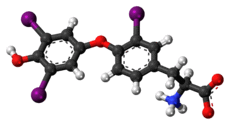 | |
 | |
| Names | |
|---|---|
| IUPAC name (2S)-2-Amino-3-[4-(4-hydroxy-3,5-diiodophenoxy)-3-iodophenyl]propanoic acid | |
| Identifiers | |
3D model (JSmol) | |
| ChEBI | |
| ChemSpider | |
IUPHAR/BPS | |
| KEGG | |
| MeSH | Reverse+triiodothyronine |
PubChem CID | |
| UNII | |
CompTox Dashboard (EPA) | |
| |
SMILES
| |
| Properties | |
Chemical formula | C15H12I3NO4 |
| Molar mass | 650.974 |
Except where otherwise noted, data are given for materials in their standard state (at 25 °C [77 °F], 100 kPa). | |
Reverse triiodothyronine (3,3’,5’-triiodothyronine, reverse T3, or rT3) is an isomer of triiodothyronine (3,5,3’ triiodothyronine, T3).
Reverse T3 is the third-most common iodothyronine the thyroid gland releases into the bloodstream, at 0.9%; tetraiodothyronine (levothyroxine, T4) constitutes 90% and T3 is 9%. However, 95% of rT3 in human blood is made elsewhere in the body, as enzymes remove a particular iodine atom from T4.[1]
The production of hormone by the thyroid gland is controlled by the hypothalamus and pituitary gland. The physiological activity of thyroid hormone is regulated by a system of enzymes that activate, inactivate or simply discard the prohormone T4 and in turn functionally modify T3 and rT3. These enzymes operate under complex direction of systems including neurotransmitters, hormones, markers of metabolism and immunological signals.
The levels of rT3 increase in conditions such as euthyroid sick syndrome because its clearance decreases while its production stays the same. The decreased clearance is possibly from lower Thyroxine 5-deiodinase activity in the peripheral tissue or decreased liver uptake of rT3.[2] In addition, increased rT3 concentrations result from upregulated Thyroxine 5-deiodinase activity in critical illness, starvation and fetal life.[3]
Reactions

References
- ^ Chopra IJ (July 1976). "An assessment of daily production and significance of thyroidal secretion of 3, 3', 5'-triiodothyronine (reverse T3) in man". J. Clin. Invest. 58 (1): 32–40. doi:10.1172/JCI108456. PMC 333152. PMID 932209.
- ^ Euthyroid Sick Syndrome at eMedicine
- ^ Chatzitomaris, Apostolos; Hoermann, Rudolf; Midgley, John E.; Hering, Steffen; Urban, Aline; Dietrich, Barbara; Abood, Assjana; Klein, Harald H.; Dietrich, Johannes W. (20 July 2017). "Thyroid Allostasis–Adaptive Responses of Thyrotropic Feedback Control to Conditions of Strain, Stress, and Developmental Programming". Frontiers in Endocrinology. 8. doi:10.3389/fendo.2017.00163. PMC 5517413. PMID 28775711.
External links
- Triiodothyronine, Reverse at the US National Library of Medicine Medical Subject Headings (MeSH)